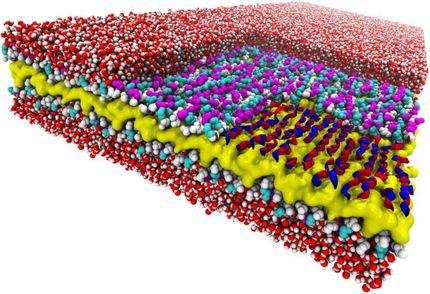Color-coding sensor: Nanostructures for contactless control
Advertisement
Chemists at Ludwig-Maximilians-Univeristaet (LMU) in Munich have fabricated a novel nanosheet-based photonic crystal that changes color in response to moisture. The new material could form the basis for humidity-sensitive contactless control of interactive screens on digital devices.

These images depict how the photonic sensor translates finger movements into color changes, as the photonic crystal reacts to the change in local humidity caused by the approach of the finger without direct contact.
LMU München
LMU chemists have developed a photonic crystal from ultrathin nanosheets which are extremely sensitive to moisture. "These photonic nanostructures change color in response to variations in local humidity. This makes them ideal candidates for the development of novel user interfaces for touchless devices," says Professor Bettina Lotsch of the Department of Chemistry at LMU and the Max Planck Institute for Solid State Research in Stuttgart.
"The humidity around a fingertip is slightly higher than the overall level of moisture in the ambient air," explains Katalin Szendrei, a member of Prof. Lotsch's research group. "This difference can be detected by our photonic sensor, and causes it to change color - without any contact with the nearby fingertip." It is this extreme sensitivity to local moisture that makes the nanostructure so interesting for use in "touchless"-screens. "Contactless control is a particularly attractive option for next-generation positioning interfaces such as ticket machines or cash dispensers, which are used by hundreds of customers each day. In this case, touchless navigation has obvious advantages with respect to hygiene," says Szendrei, pointing to one potential application for the new device.
Unparalleled sensitivity and response time
Photonic crystals are periodically arranged nanostructures which have the ability to reflect, guide and confine light. They are also found in the biological world, where examples include mother-of-pearl and the iridescent wing-scales of certain butterflies, such as the shimmering Morpho butterflies of the Amazon Basin. Lotsch and her team have now developed photonic crystals based on nanosheets of phosphatoantimonic acid. The new nanomaterial is extremely moisture sensitive and at the same time chemically stable, transparent and easy to fabricate into nanosheets. In comparison with other vapor sensors based on nanosheets, the new photonic architecture displays markedly increased response times, higher sensitivity and long-term stability. "This unique combination of properties enables it to track and color-code finger movements in real time," says Pirmin Ganter, who also works in Bettina Lotsch's group. In addition, the new system is stable on exposure to air, and therefore functions not just under controlled conditions in the laboratory but also in the constantly varying environment of the real world.
Lotsch and her collaborators have already applied for patent protection for the novel device and, together with the Fraunhofer EMFT in Munich, they are already working on a prototype screen which, in addition to providing for color-coding, will also be equipped with an electronic readout capability.

























































